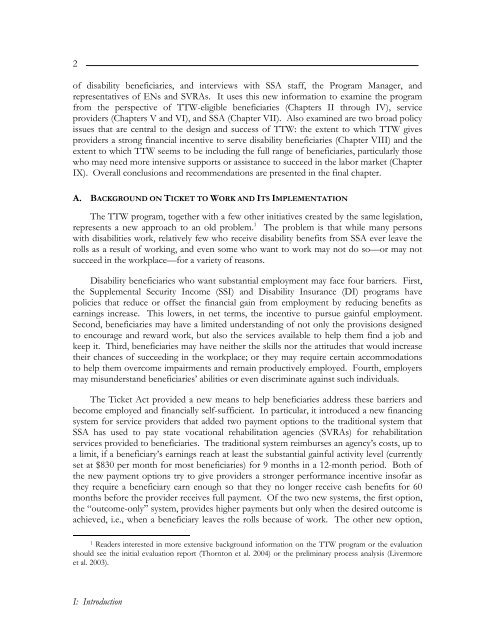Evaluation of the Ticket to Work Program, Implementation ...
Evaluation of the Ticket to Work Program, Implementation ...
Evaluation of the Ticket to Work Program, Implementation ...
Create successful ePaper yourself
Turn your PDF publications into a flip-book with our unique Google optimized e-Paper software.
2<strong>of</strong> disability beneficiaries, and interviews with SSA staff, <strong>the</strong> <strong>Program</strong> Manager, andrepresentatives <strong>of</strong> ENs and SVRAs. It uses this new information <strong>to</strong> examine <strong>the</strong> programfrom <strong>the</strong> perspective <strong>of</strong> TTW-eligible beneficiaries (Chapters II through IV), serviceproviders (Chapters V and VI), and SSA (Chapter VII). Also examined are two broad policyissues that are central <strong>to</strong> <strong>the</strong> design and success <strong>of</strong> TTW: <strong>the</strong> extent <strong>to</strong> which TTW givesproviders a strong financial incentive <strong>to</strong> serve disability beneficiaries (Chapter VIII) and <strong>the</strong>extent <strong>to</strong> which TTW seems <strong>to</strong> be including <strong>the</strong> full range <strong>of</strong> beneficiaries, particularly thosewho may need more intensive supports or assistance <strong>to</strong> succeed in <strong>the</strong> labor market (ChapterIX). Overall conclusions and recommendations are presented in <strong>the</strong> final chapter.A. BACKGROUND ON TICKET TO WORK AND ITS IMPLEMENTATIONThe TTW program, <strong>to</strong>ge<strong>the</strong>r with a few o<strong>the</strong>r initiatives created by <strong>the</strong> same legislation,represents a new approach <strong>to</strong> an old problem. 1 The problem is that while many personswith disabilities work, relatively few who receive disability benefits from SSA ever leave <strong>the</strong>rolls as a result <strong>of</strong> working, and even some who want <strong>to</strong> work may not do so—or may notsucceed in <strong>the</strong> workplace—for a variety <strong>of</strong> reasons.Disability beneficiaries who want substantial employment may face four barriers. First,<strong>the</strong> Supplemental Security Income (SSI) and Disability Insurance (DI) programs havepolicies that reduce or <strong>of</strong>fset <strong>the</strong> financial gain from employment by reducing benefits asearnings increase. This lowers, in net terms, <strong>the</strong> incentive <strong>to</strong> pursue gainful employment.Second, beneficiaries may have a limited understanding <strong>of</strong> not only <strong>the</strong> provisions designed<strong>to</strong> encourage and reward work, but also <strong>the</strong> services available <strong>to</strong> help <strong>the</strong>m find a job andkeep it. Third, beneficiaries may have nei<strong>the</strong>r <strong>the</strong> skills nor <strong>the</strong> attitudes that would increase<strong>the</strong>ir chances <strong>of</strong> succeeding in <strong>the</strong> workplace; or <strong>the</strong>y may require certain accommodations<strong>to</strong> help <strong>the</strong>m overcome impairments and remain productively employed. Fourth, employersmay misunderstand beneficiaries’ abilities or even discriminate against such individuals.The <strong>Ticket</strong> Act provided a new means <strong>to</strong> help beneficiaries address <strong>the</strong>se barriers andbecome employed and financially self-sufficient. In particular, it introduced a new financingsystem for service providers that added two payment options <strong>to</strong> <strong>the</strong> traditional system thatSSA has used <strong>to</strong> pay state vocational rehabilitation agencies (SVRAs) for rehabilitationservices provided <strong>to</strong> beneficiaries. The traditional system reimburses an agency’s costs, up <strong>to</strong>a limit, if a beneficiary’s earnings reach at least <strong>the</strong> substantial gainful activity level (currentlyset at $830 per month for most beneficiaries) for 9 months in a 12-month period. Both <strong>of</strong><strong>the</strong> new payment options try <strong>to</strong> give providers a stronger performance incentive ins<strong>of</strong>ar as<strong>the</strong>y require a beneficiary earn enough so that <strong>the</strong>y no longer receive cash benefits for 60months before <strong>the</strong> provider receives full payment. Of <strong>the</strong> two new systems, <strong>the</strong> first option,<strong>the</strong> “outcome-only” system, provides higher payments but only when <strong>the</strong> desired outcome isachieved, i.e., when a beneficiary leaves <strong>the</strong> rolls because <strong>of</strong> work. The o<strong>the</strong>r new option,1 Readers interested in more extensive background information on <strong>the</strong> TTW program or <strong>the</strong> evaluationshould see <strong>the</strong> initial evaluation report (Thorn<strong>to</strong>n et al. 2004) or <strong>the</strong> preliminary process analysis (Livermoreet al. 2003).I: Introduction
















